The Lenovo ThinkPad X1 Carbon Review (2015)
by Brett Howse on May 21, 2015 8:00 AM EST- Posted in
- Laptops
- Lenovo
- ThinkPad
- Ultrabook
- Broadwell-U
Display
Lenovo offers two display choices in the X1 Carbon, with a 1920x1080 model as the base option, and a 2560x1440 available with or without touch. While the resolution of the base panel is fine, the fact that it is a TN panel is not, so I would avoid that if at all possible. Thankfully the step up to the higher resolution model for $150 also gets you an IPS panel. With many devices that I see, there are some questionable decisions made, and I think the TN panel on a $1000+ Ultrabook is the one on this device.
Luckily Lenovo shipped the IPS panel for review. It is a 14-inch panel with a full RGB stripe. In the hardware ID the panel is just labeled as Lenovo, so I can’t say for sure who makes this panel. This model also has the touch digitizer. Despite that, it has almost a matte coating applied to it, or at least the anti-reflective coating is quite effective. This display also came with a built in ICC profile, so it was tested with that ICC being used.
To test the display characteristics, we use SpectraCal's CalMAN 5 suite along with the X-Rite i1Display Pro colorimeter for brightness and contrast readings, and the X-Rite i1Pro spectrophotometer for color accuracy testing.
Brightness and Contrast
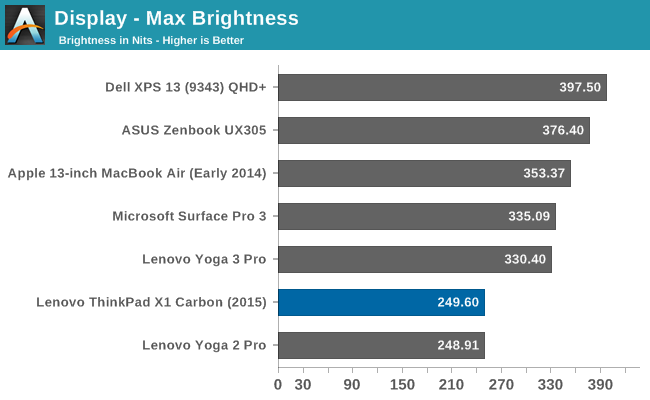
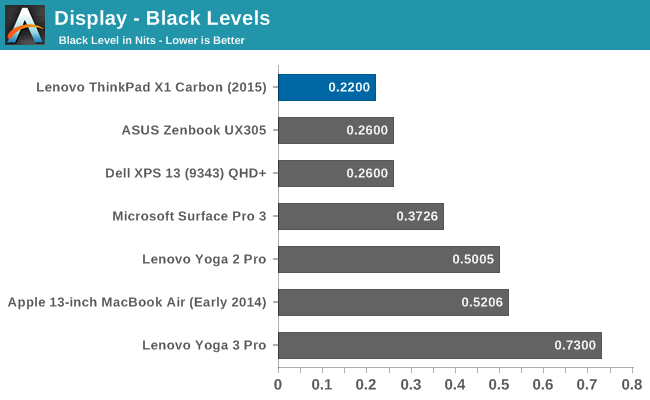
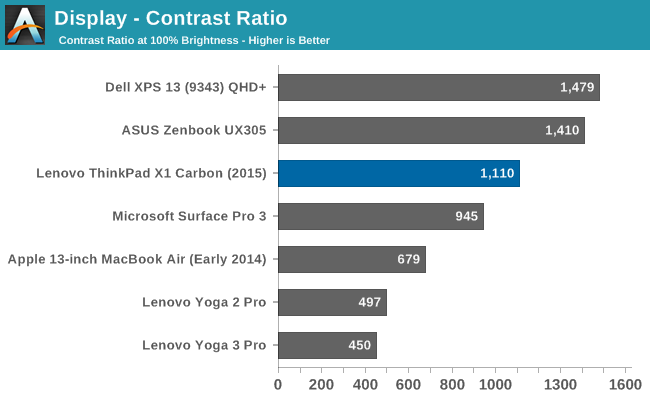
At 250 nits, the X1 Carbon does not get as bright as much of the competition. In fact, to do the color calibration steps, we set the display to 200 nits which is 92% in the power settings of this device. However black levels are quite good, so the overall contrast ratio is still a respectable 1100:1.
Grayscale
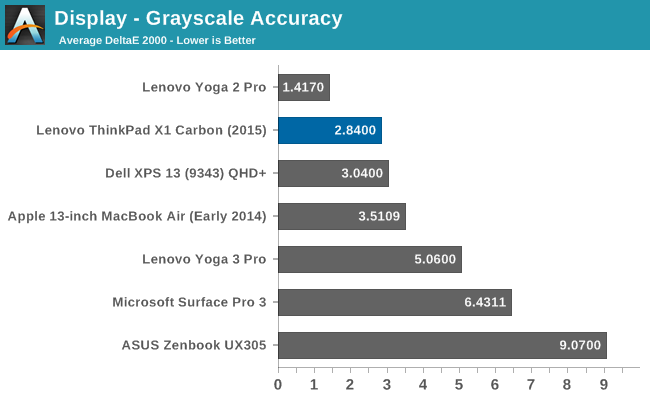
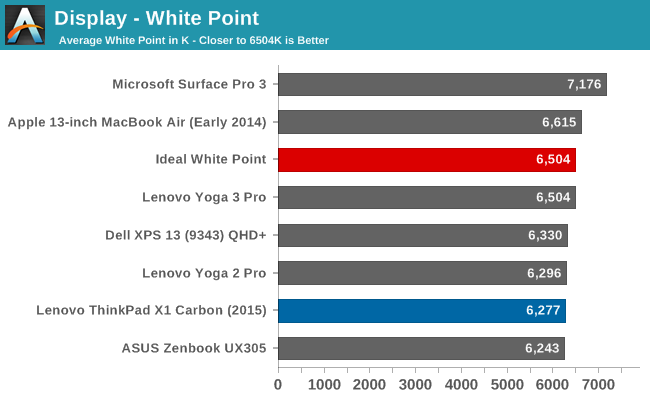
With an average score under three, the grayscale on the X1 Carbon is quite good. The errors do get a bit higher though as the brightness increases, and 100% white actually has a dE of over 5. Gamma drops down quite a bit at the higher brightness levels, and the overall gamma is just 2.0, and the target is 2.2.
Saturation

Saturation accuracy was decent on this display with an overall error level of 3.5, as an average over all of the readings. It is not the best display, but it is far from the worst. It is really the reds that drift off the most.
GMB
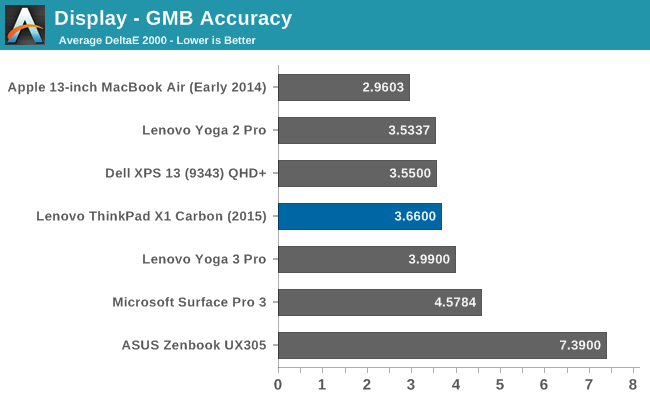
The Gretag Macbeth is the most comprehensive of the tests, and it tests quite a few colors including a lot of the flesh tones. The overall score is once again a good, but not great result, at 3.66.
The overall display is really just average, with no really standout features. The brightness is a bit low, but the contrast is good. Colors are off, but not dramatically. Out of curiosity, I also tested the display without the ICC profile as well, and surprisingly it did not have much of a change in the results. When a generic ICC profile is used, it can’t take into account variability in the individual panels.
Generally ICC profiles are the most help to grayscale, so I ran through our calibration to see how much we could improve the panel.
The grayscale sees a significant improvement, with a dE2000 of just 0.454 and gamma is almost spot on a 2.2. This is what calibration should do, so it was great to see the improvement. Unfortunately this only had a mild effect on the color related scores. Without a 3D LUT, there is only so much you can do.
One other thing that I need to mention about the display is that, at least on the sample I received, there was a bit of a twinkle in the display, which was more noticeable on light colors like white. All displays have a bit of this due to the glue and coatings applied, but on the X1 Carbon it was a bit more noticeable than I was used to.
So overall the display is just OK. Back in 2013 when the X1 Carbon first launched, a display of this quality would have been quite welcomed, but as with all things, progress moves forward and expectations get higher with the competition.

















103 Comments
View All Comments
Brett Howse - Thursday, May 21, 2015 - link
No I don't think so :) But if you do need to be able to run one over, you could get one of these http://www.business.panasonic.com/fully-rugged-lap...fokka - Thursday, May 21, 2015 - link
i agree with most things here. 4gb of RAM isn't acceptable in an ultrabook of the thinkpad brand in 2015 and neither is a TN panel. at least the days of 900p displays are over now and i prefer the 1440p display with rgb stripe to 1800p panels using some kind of pentile matrix.still, for a "professional"-grade ultrabook, which might also be used outside the office, the display is much too dim. under 300nits is a bad showing imho and with ever more efficient displays and LEDs, i would like to see more models approaching the 400nits-mark, instead of struggling to get 300.
i'm also wary of the 128gb starting config, if you ask me there should only be options from 256gb-1tb, but i guess you got to meet the lower price points somehow as well.
i'm glad lenovo came to their minds in regard to the function keys and the track pad buttons, but while they improved battery life, it still is mediocre at best. i think 50wh in a 14-inch form factor that is neither especially thin, nor has remarkably thin bezels is simply too little. 60wh would be much nicer, offering 20% more runtime, and looking how dell stuffs 52wh inside the "miniscule" xps13, 60wh should be manageable on the x1.
regarding I/O the options could be better too. two usb3 ports is the bare minimum i would expect from a thinkpad and opting for a dedicated ethernet extender port doesn't seem like the greatest idea, if you could reach the same goal with another usb port plus ethernet adapter. using usb type-c would be even better for that and you could use it for the docking port as well.
in the end it is a nice and fast machine, that's not cheap when configured properly, that is a big step up from the last iteration (but how could it not be?), but with some mediocre scores when it comes to display and runtime.
for the money one can spend on a higher end x1 i would at least like to see those two main flaws sorted out, otherwise it is a quite nice machine.
meacupla - Thursday, May 21, 2015 - link
Lenovo always lags behind others when it comes to panels offered.It's like they are purposefully obtuse about upgrading product lines to newer hardware, or are trying to make more money by skimping on their top tier products.
I really don't know of any other 'reputable' company that does this with their high end products.
edzieba - Thursday, May 21, 2015 - link
The dock you have pictured is the regular OneLink dock. The OneLink Pro dock has a DVI port in place of the HDMI, adds an extra DisplayPort output, and adds a pair of USB3 ports on the rear.Brett Howse - Thursday, May 21, 2015 - link
Fixed sorry about that!Essence_of_War - Thursday, May 21, 2015 - link
RAM is soldered down, but is the SSD soldered to the logic board also, or is that potentially end-user replaceable?Kristian Vättö - Thursday, May 21, 2015 - link
The SSD is replaceable, that's how I got early access to the Samsung SM951 in the laptop ;-)Essence_of_War - Thursday, May 21, 2015 - link
Good to know that drive failures can be addressed in-the-field!Michael Bay - Thursday, May 21, 2015 - link
I think Lenovo and bad display panels now are more or less synonymous, in notebooks at least.With prices as high as they are, would it kill them to put in something different from usual tn horrorshow for once?
der - Thursday, May 21, 2015 - link
Thank you Brett. Brett is love, Brett is life.